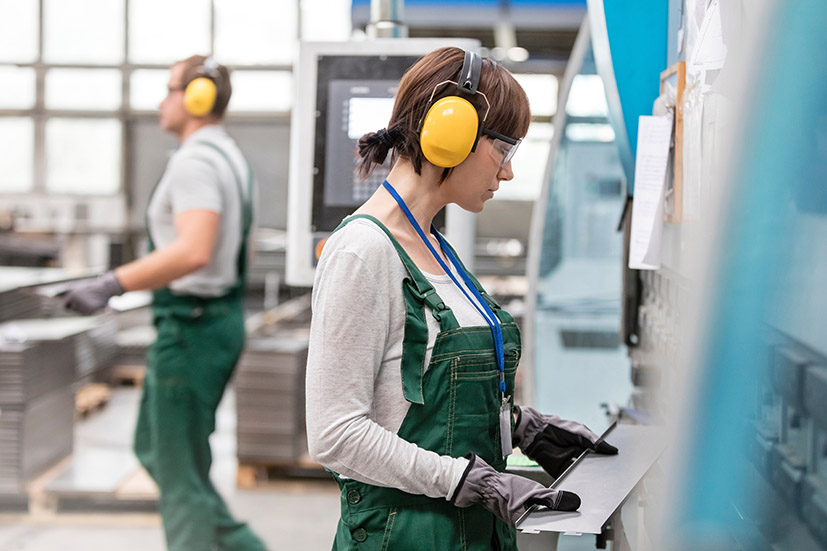Ensuring the protection of employees’ hearing in manufacturing settings is imperative for ethical and practical reasons. Factories, marked by the pervasive hum of machinery, expose workers to continuous noise levels that, if unaddressed, pose substantial risks to auditory health.
Beyond meeting regulatory obligations, implementing effective measures becomes a strategic investment in the workforce’s well-being. The sustained exposure to elevated noise levels can lead to irreversible hearing damage, impacting employees’ overall health and productivity. Responsible industrial management involves adopting comprehensive hearing protection measures for a safer work environment and the workforce’s long-term health and resilience. What are some of the measures that can be implemented? Keep reading to find out more.
Understanding Hearing Hazards In Factories
Factories inherently expose workers to a symphony of noise, potentially leading to irreversible hearing damage. To comprehend and mitigate these hazards:
- Undertake a meticulous noise assessment.
- Utilize precision tools such as decibel meters to pinpoint areas with elevated noise levels.
- Identify the specific machinery or processes contributing to these levels.
This analysis forms the foundation for a targeted hearing protection strategy, allowing you to tailor solutions to the unique acoustic landscape of your factory. A thorough understanding of your auditory environment empowers you to make informed decisions and implement precise measures for effective hearing conservation.
Assessing The Factory Environment
Conducting a thorough noise assessment is paramount for an effective hearing protection strategy. Pinpoint areas where noise levels peak and identify machinery contributing to elevated decibel counts. Use precision tools like decibel meters to ensure accuracy in your assessment. This process enables you to create a tailored protection plan. Implementing strategic noise control measures in identified high-noise zones contributes significantly to the overall effectiveness of your hearing protection strategy. Regularly reassess the factory soundscape to adapt measures to evolving conditions, ensuring sustained protection for your team.
Selecting Appropriate Hearing Protection
The quest for effective hearing protection begins with the selection of appropriate equipment. Earmuffs, earplugs, and other devices vary in effectiveness and comfort, but prioritise proper fitting to ensure long-term use without compromising comfort. Establish a comprehensive training program to educate your team on adequately using and maintaining hearing protection equipment. Offering a range of options and ensuring their correct usage fosters a safety culture, empowering individuals to make choices tailored to their unique needs.
Consider The Choice Of Equipment
Strategically investing in silent, quiet, and low-noise air compressors is a pivotal choice in hearing protection. Recognize the contribution of air compressors to overall noise levels and explore options designed to minimize their impact. Prioritize equipment known for its quiet operation without compromising efficiency, such as the Champion Air Tech. This investment extends beyond fulfilling operational needs; it creates a quieter work environment. Making informed choices about your equipment means you actively enhance hearing protection measures, fostering a workplace where your team’s auditory health is prioritized.
Implementing Hearing Conservation Programs
Establishing a comprehensive hearing conservation program requires proactive measures. Educate your team about the risks of high noise levels and the importance of hearing protection. Develop a structured training program to familiarize individuals with the correct use of protective equipment. Regular awareness campaigns reinforce the significance of hearing safety, promoting a culture where employees are actively engaged in their auditory well-being. By instilling a sense of responsibility and understanding, your team becomes integral to the hearing protection program, contributing to a safer and healthier workplace environment.
Utilizing Engineering Controls
The implementation of engineering solutions serves as a pivotal step in noise reduction. Identify specific noise sources and introduce controls such as barriers, enclosures, and soundproofing measures. Tailor these engineering controls to the unique requirements of your factory environment. Regularly assess the effectiveness of these measures and adjust as needed. Strategically integrating engineering controls means you address noise at its source and contribute to a sustainable and comfortable work environment.
Regular Monitoring And Maintenance
Continuous monitoring of noise levels is imperative for sustained hearing protection. Implement routine maintenance for hearing protection equipment, ensuring optimal functionality. Regular reviews of the hearing conservation program guarantee its effectiveness. Utilize feedback from employees to make necessary adjustments and improvements. By adopting a proactive stance in monitoring and maintenance, you address emerging issues promptly and demonstrate a commitment to the ongoing well-being of your team. This iterative approach ensures that your hearing protection measures remain robust and adaptive to changing workplace conditions.
Compliance With Regulations
Adherence to regulatory standards is non-negotiable for hearing protection in factories. Familiarize yourself with industry-specific requirements and proactively ensure compliance. Regular audits and assessments guarantee that your factory meets or exceeds stipulated standards. Non-compliance can result in severe consequences, including fines and potential legal repercussions. By prioritizing regulatory adherence, you not only mitigate legal risks but also affirm your commitment to creating a workplace that prioritizes the health and safety of your team.
Preserving your team’s hearing in a factory environment demands a focused and strategic approach. By making informed choices and fostering a culture of hearing safety, you meet regulatory obligations and prioritize the well-being of your most valuable asset – your team. Implement these practical steps today and secure a sound future for your workforce.



